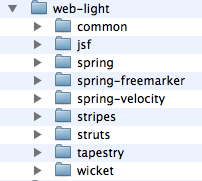The Future of Web Frameworks at TSSJS
 For TSSJS Vegas 2010, I submitted two proposals for talks: GWT vs. Flex Smackdown and The Future of Web Frameworks. As of today, the 2nd is the only one that shows up on the conference agenda, but hopefully the former will get accepted too. Here's a description of this talk:
For TSSJS Vegas 2010, I submitted two proposals for talks: GWT vs. Flex Smackdown and The Future of Web Frameworks. As of today, the 2nd is the only one that shows up on the conference agenda, but hopefully the former will get accepted too. Here's a description of this talk:
With rich Ajax applications and HTML5 on the horizon, are web frameworks still relevant? Java web frameworks like Struts and Spring MVC were all the rage 5 years ago. Component-based frameworks like Tapestry, JSF and Wicket made it easier to create re-usable applications. But what about the Mobile Web and offline applications?
Are Titanium, Adobe Air and Gears the future? If you're embracing the RESTfulness of the web, do you even need a web framework, or can you use use JAX-RS with an Ajax toolkit?
These questions and many more are examined, answered and debated in this lively session. Bring your opinions and experiences to this session to learn about what's dead, what's rising and what's here to stay. If you're a web framework fan, this session is sure to please.
I believe this talk will be a lot of fun to create and deliver. To create it, I'd like to make it a collaborative effort with the web framework community (users and developers). To kick things off, below is an initial rough outline/agenda:
- Title
- Introduction
- Problem/Purpose
- Agenda
- How did we get here?
- Where are we going?
- How do we get there?
- Q and A
- History of Web Frameworks
- Deep History (CGI, etc.)
- Java's Rise
- PHP
- Rails -> Grails
- Ajax Frameworks
- RESTify!
- SOFEA, APIs, etc.
- The Future
- HTML5
- GWT, Cappucino and Spoutcore (compare to Java and compilers)
- The Binary Players (Flex, JavaFX and Silverlight)
- Getting Rich
- Speed (is it a problem? YES!)
- IE 6 will die.
- Chrome OS
- The Mobile Web
- Desktop Webapps (Titanium, AIR, etc.)
- Or is this the present? Future is bleeding edge.
- Getting There: It's all about the APIs
- Allows for any client
- Web Framework skills transfer to desktop - and phone!
- Speed will continue to be *very* important
- Innovation, something we haven't thought of
- Fallout
- Interest in server-side frameworks will continue, but frameworks will become unmaintained
- Ajax Frameworks will continue to innovate
- HTML5 Frameworks?
- IE 6 (hopefully!)
- Desktop and Mobile with Web Technologies
- Watch out for the next big thing! (or What do you think is the next big thing?)
- Conclusion
- Q and A
Is there anything I'm missing that's important for the future of web frameworks? Are there items that should be removed? Any advice is most welcome.
Reminder: I'll be speaking at tomorrow's DJUG if you'd like to discuss your thoughts in person.







